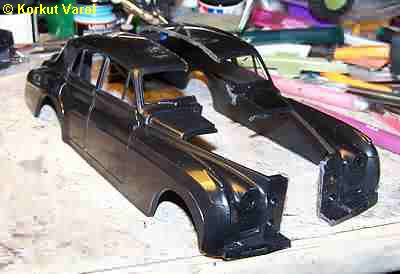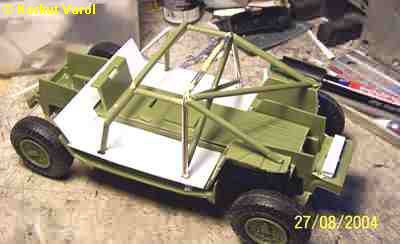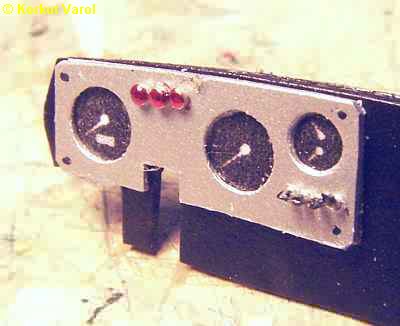| Dirt Track Rolls Royce |  |
Kits used:
Minicraft 11209 Rolls Royce Silver Cloud
Revell Snap 85-1909 Humvee
.
Started: 18 August 2004
Finished: 13 September 2004
Page 1 of 2
18 August 2004:
This was the first visual check of how it could look. The wheelbases were almost the same but the RR body had to be widened by 10 mm.

I cut the body, hood and the boot of the RR in two.

Putting on the Hummer chassis, I marked where I should cut open the wheelarches.

After cutting out the wheelarches, I cut 10 mm wide strips of styrene and glued them all along, joining the two halves. I made a wider reinforcing strip under the body panels, so the glued straight lines would not be weak.

21 August 2004:
Naturally, enough putty followed.

The gas filler cap was traced as a "positive" line, so I traced it over into the body panel.


I painted the body flat white to see imperfections. Also here is a mockup with the grille in place.

27 August 2004:
I
prepared the floor pan. I had trimmed
the chassis before, to fit the body and now I glued two pieces of
styrene
on the two sides of the middle tunnel and drilled the holes to fit the
roll cage.

I constructed the roll cage in place, continuously checking the fit with the body.

28 August 2004:
I drilled the headlamp recesses and though not very clear in the photo, I glued a cup from a pill holder inside. The car won't have any headlamps.

29 August 2004:
The cluster below are the cardboard templates that I used for determining the exact height and shape of the dashboard with respect to the chassis. The dashboard will be held on the body while the roll cage is on the chassis; so a very good matching in assembly was necessary. The dashboard is seen in the lower part of the photo.


This is as the epoxy cured, everything fitting well in place.

30 August 2004:
I got a steering wheel from my parts box and glued a styrene tubing and fitted temporarily to check the proper angle.

I painted the dashboard black and cut out the gauges' plate from styrene.



 .............................
.............................